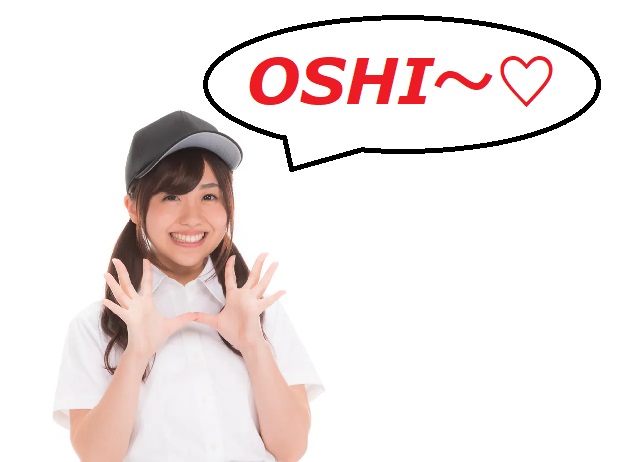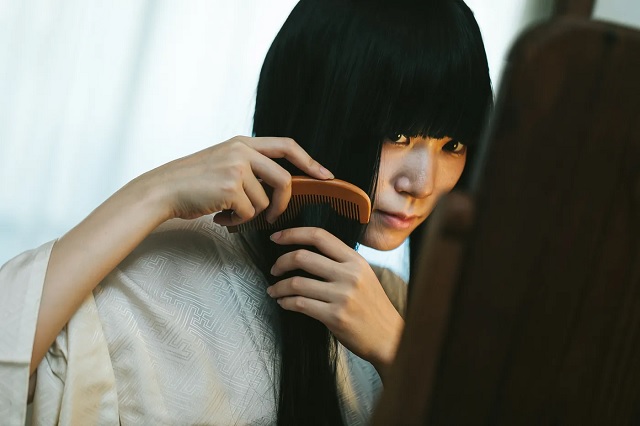
And the vast majority want to look good when they go to see them.
Like all languages, Japanese is constantly evolving, and one word that’s taken on a new meaning in recent years is oshi. Originally the noun-form of the verb osu, or “support,” it’s been adopted in fan culture to mean a celebrity or character that one feels a singularly strong devotion to, such as a favorite idol singer, voice actor or anime star.
Developing that sort of crush on a person you’ve never met, or a character who isn’t actually real, might seem like the exclusive proclivity of male otaku, but there’s no shortage of women with an oshi as well. To gauge just how many, Japanese marketing research firm Cross Marketing surveyed 500 women between the ages of 20 and 49, and found that nearly half, 46.6 percent, have an oshi.
Part of having an oshi is engaging in oshikatsu, or “oshi activities,” such as going to concerts, meet-and-greets, and other fan events. When asked about their preparations for oshikatsu events, the vast majority of women with an oshi, 81.8 percent, say they make an extra effort to look their best before their arrive, with their specific ways of dolling themselves up listed below:
Before going to an oshikatsu event, I:
● Use skincare products: 79.5 percent of respondents with an oshi
● Go on a diet: 65.8 percent
● Make sure my hair is done nicely: 59 percent
● Make sure my nails are done nicely: 43.6 percent
● Make sure my legs look nice (with special massages or by wearing compression socks): 27.4 percent
● Other: 5.1 percent▼ Gotta do that oshikatsu pre-gaming.
Of course, with the pandemic still going on, the number of oshikatsu events are way down, and those that are happening are much smaller in scale. The respondents are hoping things get back to normal soon, though. Out of the 500 women polled, when asked, in general, what they want to do once the pandemic ends, 16.8 percent say they’re looking forward to being able to see their oshi at event venues again, which was more women who said they’re looking forward to visiting their hometowns and seeing their parents (15.2 percent). Considering that those numbers are for the full field of respondents, not just the women who have an oshi, the pull of an oshi’s allure looks to be especially strong for those who’ve found one.
Source: PR Times
Top image: Pakutaso (edited by SoraNews24)
Insert image: Pakutaso
● Want to hear about SoraNews24’s latest articles as soon as they’re published? Follow us on Facebook and Twitter!
[ Read in Japanese ]


 Do Japanese superfans really want to marry their favorite idol?【Survey】
Do Japanese superfans really want to marry their favorite idol?【Survey】 Support your faves and avoid oshikatsu burnout — advice from our resident otaku
Support your faves and avoid oshikatsu burnout — advice from our resident otaku Tokyo police create public service warning about kids obsessing over their favorite male idols
Tokyo police create public service warning about kids obsessing over their favorite male idols Dedicate your savings to your oshi of choice with this new buildable offertory box
Dedicate your savings to your oshi of choice with this new buildable offertory box Rich and bald or handsome and poor? Survey asks Japanese women who’d they’d rather marry
Rich and bald or handsome and poor? Survey asks Japanese women who’d they’d rather marry Japan’s new difficult-to-drink-from beer glass protects your liver, but it’s a brutal experience
Japan’s new difficult-to-drink-from beer glass protects your liver, but it’s a brutal experience Demon Slayer: Kimetsu no Yaiba gets new roller coaster attractions and food at Universal Studios Japan
Demon Slayer: Kimetsu no Yaiba gets new roller coaster attractions and food at Universal Studios Japan How to order snacks on a Shinkansen bullet train in Japan
How to order snacks on a Shinkansen bullet train in Japan New samurai glasses are Japan’s latest weird must-have souvenir
New samurai glasses are Japan’s latest weird must-have souvenir Hello, cosmetics! Clinique teams up with Hello Kitty this summer for first-time collaboration
Hello, cosmetics! Clinique teams up with Hello Kitty this summer for first-time collaboration High-fashion Totoro cuddle purse is like an elegant stroll in the forest【Photos】
High-fashion Totoro cuddle purse is like an elegant stroll in the forest【Photos】 Burger King Japan suddenly adds Dr. Pepper and Dr. Pepper floats to its menu nationwide
Burger King Japan suddenly adds Dr. Pepper and Dr. Pepper floats to its menu nationwide New Nintendo Lego kit is a beautiful piece of moving pixel art of Mario and Yoshi【Photos】
New Nintendo Lego kit is a beautiful piece of moving pixel art of Mario and Yoshi【Photos】 Japan’s cooling body wipe sheets want to help you beat the heat, but which work and which don’t?
Japan’s cooling body wipe sheets want to help you beat the heat, but which work and which don’t? Nintendo history you can feel – Super NES, N64, and GameCube controllers become capsule toys
Nintendo history you can feel – Super NES, N64, and GameCube controllers become capsule toys “The most Delicious Cup Noodle in history” – Japan’s French Cup Noodle wins our heart【Taste test】
“The most Delicious Cup Noodle in history” – Japan’s French Cup Noodle wins our heart【Taste test】 Starbucks releases a cute Frappuccino and Unicorn Cake…but not in Japan
Starbucks releases a cute Frappuccino and Unicorn Cake…but not in Japan Kyoto Tower mascot termination reveals dark side behind cute Japanese characters
Kyoto Tower mascot termination reveals dark side behind cute Japanese characters McDonald’s Japan’s Soft Twist Tower: A phantom ice cream only sold at select branches
McDonald’s Japan’s Soft Twist Tower: A phantom ice cream only sold at select branches Yabai Ramen: What makes this Japanese ramen so dangerous?
Yabai Ramen: What makes this Japanese ramen so dangerous? Finally! Nintendo Japan expands Switch 8-bit controller sales to everybody, Online member or not
Finally! Nintendo Japan expands Switch 8-bit controller sales to everybody, Online member or not Japanese government wants to build luxury resorts in all national parks for foreign tourists
Japanese government wants to build luxury resorts in all national parks for foreign tourists To combat declining birth rate, Japan to begin offering “Breeding Visas” to foreigners
To combat declining birth rate, Japan to begin offering “Breeding Visas” to foreigners 10 things you should buy at 7-Eleven in Japan
10 things you should buy at 7-Eleven in Japan Studio Ghibli releases anime heroine cosplay dresses that are super comfy to wear
Studio Ghibli releases anime heroine cosplay dresses that are super comfy to wear Woman charged for driving suitcase without a license in Osaka
Woman charged for driving suitcase without a license in Osaka Studio Ghibli unveils My Neighbour Totoro miniature house model
Studio Ghibli unveils My Neighbour Totoro miniature house model Kyoto experiencing problems with foreign tourists not paying for bus fares, but not on purpose
Kyoto experiencing problems with foreign tourists not paying for bus fares, but not on purpose Fighting mild hunger with a Japanese soda that turns into jelly in the stomach【Taste test】
Fighting mild hunger with a Japanese soda that turns into jelly in the stomach【Taste test】 Studio Ghibli’s Howl’s Moving Castle tapestry unveiled in Japan for first time
Studio Ghibli’s Howl’s Moving Castle tapestry unveiled in Japan for first time McDonald’s new Happy Meals offer up cute and practical Sanrio lifestyle goods
McDonald’s new Happy Meals offer up cute and practical Sanrio lifestyle goods Sales of Japan’s most convenient train ticket/shopping payment cards suspended indefinitely
Sales of Japan’s most convenient train ticket/shopping payment cards suspended indefinitely Sold-out Studio Ghibli desktop humidifiers are back so Totoro can help you through the dry season
Sold-out Studio Ghibli desktop humidifiers are back so Totoro can help you through the dry season Japanese government to make first change to romanization spelling rules since the 1950s
Japanese government to make first change to romanization spelling rules since the 1950s Foreigner’s request for help in Tokyo makes us sad for the state of society
Foreigner’s request for help in Tokyo makes us sad for the state of society Ghibli founders Toshio Suzuki and Hayao Miyazaki contribute to Japanese whisky Totoro label design
Ghibli founders Toshio Suzuki and Hayao Miyazaki contribute to Japanese whisky Totoro label design Doraemon found buried at sea as scene from 1993 anime becomes real life【Photos】
Doraemon found buried at sea as scene from 1993 anime becomes real life【Photos】 Tokyo’s most famous Starbucks is closed
Tokyo’s most famous Starbucks is closed Princesses, fruits, and blacksmiths: Study reveals the 30 most unusual family names in Japan
Princesses, fruits, and blacksmiths: Study reveals the 30 most unusual family names in Japan Let’s eat our favorite anime characters’ hair, says Tokyo cafe
Let’s eat our favorite anime characters’ hair, says Tokyo cafe 31 percent of Japanese women admit to cheating on lover, six percent say they got caught【Survey】
31 percent of Japanese women admit to cheating on lover, six percent say they got caught【Survey】 Our reporter illustrates their first experience attending a fan photo event with an oshi
Our reporter illustrates their first experience attending a fan photo event with an oshi Oshi kamidana – Literal altars you can build to enshrine your favorite anime character or idol
Oshi kamidana – Literal altars you can build to enshrine your favorite anime character or idol What’s the best way to eat Japanese cream stew and rice, “together” or “separate?”【Survey】
What’s the best way to eat Japanese cream stew and rice, “together” or “separate?”【Survey】 Celebrate your oshi’s birthday in style with this fully customisable cake
Celebrate your oshi’s birthday in style with this fully customisable cake Japanese company allows workers to take vacation to grieve if favorite idol singer gets married
Japanese company allows workers to take vacation to grieve if favorite idol singer gets married Japanese otaku now have special trash box just for merch of their former anime and idol crushes
Japanese otaku now have special trash box just for merch of their former anime and idol crushes Uniqlo creates Oshi no Ko T-shirt line so you can show support for anime idols【Photos】
Uniqlo creates Oshi no Ko T-shirt line so you can show support for anime idols【Photos】 Over 94 percent of Japanese people in survey find movie theater prices too expensive
Over 94 percent of Japanese people in survey find movie theater prices too expensive Majority of younger Japanese people in survey respect less than 30 percent of their old coworkers
Majority of younger Japanese people in survey respect less than 30 percent of their old coworkers Only one demographic in survey is happy about Japan’s workplace obligation Valentine’s chocolate
Only one demographic in survey is happy about Japan’s workplace obligation Valentine’s chocolate Is it OK to split the bill on a date in Japan? Survey asks what women and men of different ages think
Is it OK to split the bill on a date in Japan? Survey asks what women and men of different ages think What will 2021 mean for Valentine’s Day in Japan? Survey asks teens their chocolate plans
What will 2021 mean for Valentine’s Day in Japan? Survey asks teens their chocolate plans Japanese employees show almost unanimous support for in-office romances in survey
Japanese employees show almost unanimous support for in-office romances in survey Some important Christmas shopping advice for parents of otaku and fujoshi kids
Some important Christmas shopping advice for parents of otaku and fujoshi kids
Leave a Reply